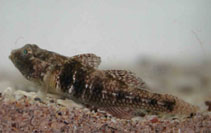| Family: |
Gobiidae (Gobies), subfamily: Gobionellinae |
| Max. size: |
3.05 cm SL (male/unsexed); 2.95 cm SL (female) |
| Environment: |
demersal; marine; depth range 0 - 8 m |
| Distribution: |
Indo-Pacific: known from Merimbula, New South Wales, throughout Tasmania, Victoria, and west to Kangaroo I., South Australia. |
| Diagnosis: |
Dorsal spines (total): 7-7; Dorsal soft rays (total): 6-7; Anal spines: 0-0; Anal soft rays: 8-10. This species differs by the following characters: 1st D VII; 2nd D 8-11, rarely 8 or 11; A 8-10; no spine in 2nd dorsal or anal fin; branched caudal-fin rays 11-12; pectoral-fin rays 16-20; no head pores; wide gill opening reaching forward to below or slightly before posterior preopercular margin; scales reaching to above preoperculum in the head, sometimes almost to eye; dorsal mid-line of nape naked or rarely with a single scale just before 1st dorsal fin, but scales often present just to side of midline; body scales ctenoid, in 25-30 rows; midline of belly without scales or with a few scales posteriorly; pectoral base usually without scales or with 1 or 2 cycloid scales ventrally; area before pelvic fin n with cycloid scales; body deep, depth at anal origin subequal to or greater than caudal fin length; 1st dorsal fin low, with rounded or triangular shaped margin (Ref. 76773). |
| Biology: |
Inhabits sand around sea grass beds and around rocky reefs (Ref. 76773). |
| IUCN Red List Status: |
Not Evaluated (N.E.) Ref. (130435)
|
| Threat to humans: |
|
Source and more info: www.fishbase.org. For personal, classroom, and other internal use only. Not for publication.
